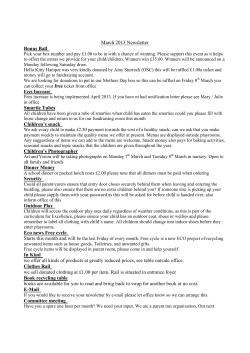
Answers To Questions That Adults Have About Orthodontic Treatment
Answers To Questions That Adults Have About Orthodontic Treatment (NAPSA)—In the ever-evolving practice of orthodontics, two trends stand out above the rest—more adults are seeking treatment, and they have more options than ever before. According to a survey by the American Association of Orthodontists (AAO)—which represents more than 17,000 orthodontists throughout the U.S., Canada and abroad—more than 20 percent of current orthodontic patients are adults. That’s well over 1 million people learning that a healthy, beautiful smile is possible at any age. But while the ease, availability and options for orthodontic treatment have never been greater for adults, it can be overwhelming for them to sort through their choices. The solution? The AAO recommends seeking counsel from an orthodontic specialist to cut through the hearsay and become an informed, proactive patient. To help those considering treatment, the experts in orthodontic treatment provided the tips below. Five questions to ask to be an informed patient: How do I find a qualified orthodontic specialist near me? •AAO’s website, www.MyLife MySmile.org, has a helpful module that locates orthodontists by street address, city, state and/or zip/postal code. Visitors can also take advantage of the site’s “Frequently Asked Questions” and “Ask an Orthodontist” sections to get answers from a specialist. Which treatment option is right for my lifestyle? •Each case is unique, but many treatments fit an adult lifestyle. Some orthodontists offer lingual braces, which feature brackets bonded behind the teeth; ceramic braces, which blend with With all the newer options available to or thodontic patients, more and more adults are seeking treatment. the color of the tooth to lessen visibility; or a series of invisible aligner trays (clear aligners) to correct certain problems. Which treatment plan will give me the fastest and most permanent results? •Very often, adult patients have already made up their minds as to which treatment options they’d like to pursue. It is important to ask an orthodontist if the selected treatment will achieve the desired results. How can I afford treatment? •Orthodontic treatment is more affordable than ever because orthodontists offer a variety of payment plans and options. Insurance may cover adult orthodontic treatment, and 60 percent of all new patients in 2010 had dental insurance that included orthodontic benefits. I’m always busy—will orthodontic treatment fit into my lifestyle? •New technology = less frequent visits. On average, orthodontists see patients only once every six weeks and complete treatment in 22 months. Delight Loved Ones With An Edible Easter Basket Or One That’s Environmentally Friendly (NAPSA)—Colorful Easter baskets are a seasonal tradition every spring. Easter baskets are fun to make but also delicious to dive into. Did you know that mothers make an average of four baskets during the Easter season? In fact, four out of five moms purchase candy just to fill up these baskets. Environmentally Friendly Easter Basket Making an environmentally friendly Easter basket is even easier than you might imagine and these common materials can be found at a nearby major retail store. Start by selecting a special Easter basket considering size and the favorite colors and designs of the person who will receive this one-of-a-kind gift. Choose a basket made of Earth-friendly products such as bamboo. Pick a filling material like straw or crinkle paper instead of plastic for the bottom of the basket. Then fill it to the brim with Easter favorites, surprise trinkets, educational toys and some of this season’s newest treats. Lastly, consider skipping the plastic wrap to cover the basket and pack basket items tightly so they do not fall out. Among this year’s tastiest surprises is the new Nestlé Crunch Paul Frank “Julius the Bunny” made of delicious Nestlé Crunch chocolate. Consider a few jazzedup perennial hits, such as SweeTARTS Gummies, a bunny-shaped sweet twist on gummy candies, or SweeTARTS Jelly Beans, which feature that familiar sweet and tart kick in jelly-bean form. To brighten the day of anyone you are sweet on this Easter season, try baking up some chocolate string licorice in various colors; cut in three-inch pieces for basket handles (optional) This fun chocolate chip cookie dough basket filled with tinted coconut and topped with candy is totally edible and deliciously delightful. chip cookie dough into edible Easter baskets. Chocolate Chip Easter Baskets Servings: 24 baskets Preparation time: 45 minutes Cooking time: 14 minutes Ingredients: 1 package (16.5 oz.) Nestlé Toll House Refrigerated Chocolate Chip Cookie Dough 1 cup prepared white or vanilla frosting Green food coloring 1 ⁄4 cup sweetened coconut flakes 1 bag of Wonka SweeTARTS,Wonka Spree Jelly Beans or Wonka Nerds Jelly Beans, Thin- Instructions: 1. Preheat oven to 350° F. Grease and flour 24 minimuffin cups. Place one square of cookie dough into each cup. 2. Bake for 14 to 17 minutes or until golden brown. Remove pan to wire rack. If you wish to add licorice handles, take the tip of a wooden pick and make two holes opposite each other on the top edge of the cup. Make sure holes are the same size as the width of the licorice. This is best done when cups are very warm. Cool cups completely in pans on wire rack. With the tip of a butter knife, remove cookie cups from muffin pans. Arrange on a serving platter. 3. Combine frosting and a few drops of food coloring in small bowl, adding additional food coloring until desired shade is achieved. 4. Dissolve a few drops of food coloring in 1⁄4 teaspoon water in small, resealable food storage plastic bag. Add coconut. Seal bag and shake to evenly coat coconut with color. 5. Spoon a small amount of frosting onto the top of each cup. Add a pinch of tinted coconut. Top the “grass” with Wonka SweeTARTS, Wonka Spree Jelly Beans or Wonka Nerds Jelly Beans. Insert ends of licorice into small holes in cups for handles. If Your Skin Could Talk, What Would It Say? (NAPSA)—Sleep apnea increases snoring and may make you more likely to have a car accident, says the Las Vegas Institute for Advanced Dental Studies. Fortunately, a dental device resembling an athlete’s mouth guard is 70 percent successful at treating sleep apnea. Learn more at www.leadingdentists.com. *** Blind individuals experiencing symptoms of Non-24-Hour may participate in clinical trials led by Vanda Pharmaceuticals evaluating an investigational treatment. For more information, call (888) 389-7033, email info@non24registry.com or visit www.non24registry.com. *** According to the Centers for Disease Control and Prevention, poisoning is now the leading cause of injury death, even more than motor vehicle accident fatalities. Poisoning can be prevented. For more information, call the Poison Help line at 1-800-222-1222 or visit www.PoisonHelp.hrsa.gov. *** Experts say that allergy sufferers should use clean, fresh lenses— such as 1-Day Acuvue Moist Brand Contact Lenses—each day to minimize the potential for the buildup of irritants and allergens. To learn more, visit www.acuvue.com. (NAPSA)—What is your skin telling you? Did you spend a lot of time in the sun last summer? What about the summer before that? Sun exposure on unprotected skin year after year may leave you with more than a few freckles. Sunburns and moles aren’t the only indication that skin has been damaged. After years of exposure to the sun, you may discover red spots that feel rough, dry or scaly and don’t go away, even after using moisturizer. Sometimes called “sun spots” or mistaken for age spots, these patches could be actinic keratosis (AK), a skin condition that can lead to squamous cell carcinoma (SCC), a nonmelanoma form of skin cancer. It is estimated that AK affects up to 58 million Americansi, yet most people are unaware of its symptoms and association with sun damage. Because AK is a result of cumulative sun exposure, it can take years to develop. A job that requires a substantial amount of time outside or everyday activities such as gardening, exercise or attending outdoor For more information on how to find out what your skin is telling you, see your doctor and visit www.listentoyourskin.org. sporting events can lead to sun damage if your skin isn’t adequately protected. People at high risk are often fair-skinned men and women over the age of 40 who may have accumulated a significant amount of sun exposure over the course of many years. One in five Americans will develop skin cancer in the course of their lifetime ii, and AKs have the potential to progress to squamous cell carcinoma, the second most common type of skin cancer. It’s important to check your skin year-round and note any changes in texture and color—these changes may be age spots, irritation or dry skin, but they may also require more attention. According to the National Institutes of Health, specific characteristics of AK includeiii: •A skin patch or growth, often limited to one area, that begins as flat and scaly; •Presence on the face, scalp, back of the hands, chest or other sun-exposed areas; •A color that can be gray, pink, red or the same color as the skin; •Later development into a hard and wart-like or gritty, rough and “sandpapery” surface; •In some cases, the lesions may be easier to feel than to see. For more information on how to find out what your skin is telling you, see your doctor and visit www.listentoyourskin.org. i Lewin Group. Burden of Skin Diseases. 2005. Prepared for The Society for Investigative Dermatology and the American Academy of Dermatology Association. Available at: http://www.lewin.com/~/media/lewin/site_sections/publications/april2005skindisease.pdf. Accessed November 1, 2011. ii Robinson JK. Sun Exposure, Sun Protection, and Vitamin D. JAMA 2005; 294: 1541-43. iii “Actinic Keratosis.” Medline Plus. National Library of Medicine and National Institutes of Health, updated October 8, 2010. Accessed November 21, 2011. <http://www.nlm.nih.gov/medlineplus/ency/article/000827.htm>. 13
© Copyright 2025





















